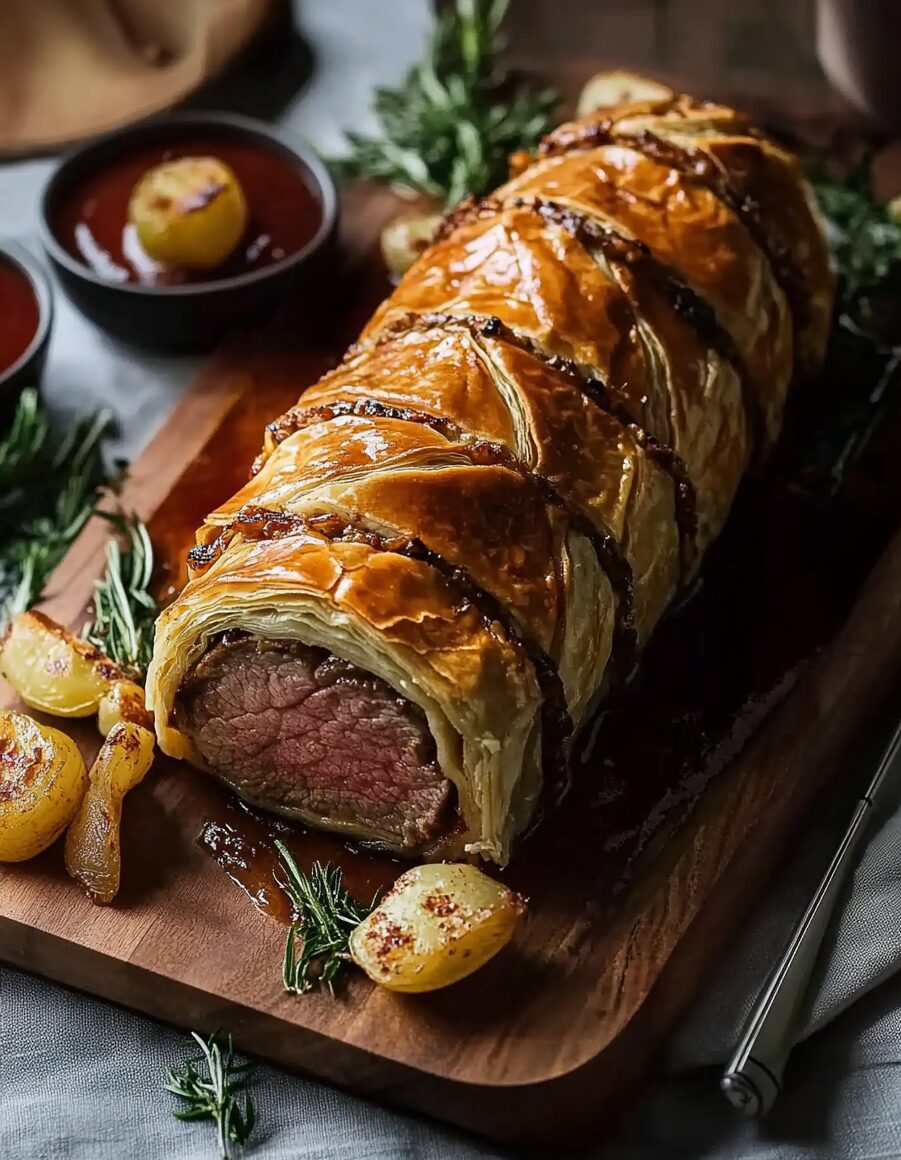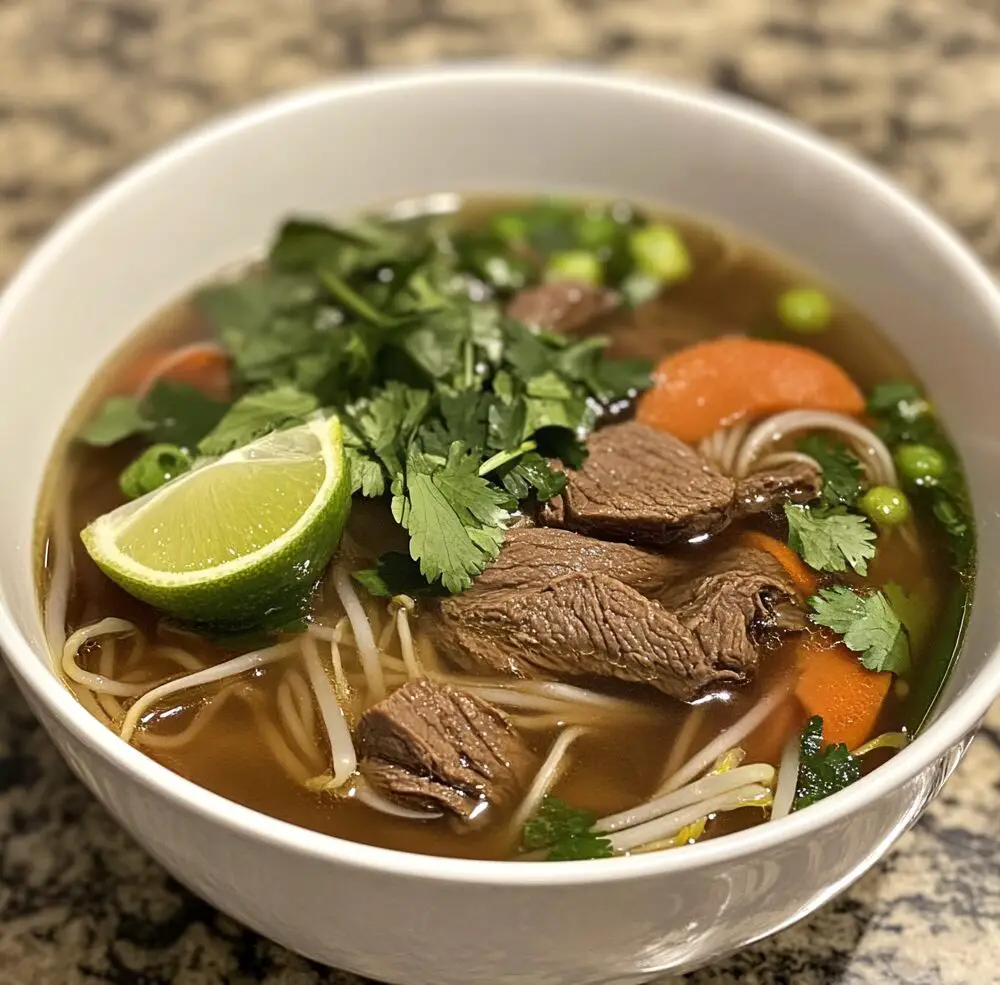The classic Beef Wellington is an elegant dish featuring tender beef tenderloin wrapped in a golden puff pastry crust. The savory filling of paté, onions, and mushrooms adds layers of richness and flavor, while the puff pastry bakes to a perfect, flaky finish. This recipe is perfect for special occasions like holidays or anniversaries, where you want to impress your guests with a timeless dish. While it takes some time to prepare, the result is a luxurious entrée that looks and tastes like a work of art.
Full recipe:
Ingredients:
- 2 lbs beef tenderloin
- 2 tablespoons butter, divided
- 1 onion, chopped
- 1/2 cup mushrooms, chopped
- 2 tablespoons paté
- 1 sheet puff pastry, thawed
- 1 egg yolk, beaten
- Salt and pepper to taste
Directions:
- Preheat oven to 425°F (220°C).
- Season the beef with salt and pepper. Melt 1 tablespoon of butter in a skillet over medium-high heat. Brown the beef on all sides, then set aside to cool.
- In the same skillet, sauté onions and mushrooms in the remaining butter until soft. Allow to cool.
- Mix the paté with softened butter, and spread it evenly over the cooled beef.
- Roll out the puff pastry, placing the beef in the center. Spread the onion and mushroom mixture over the beef, then wrap the pastry around the beef, sealing the edges tightly.
- Place the beef Wellington on a baking sheet, seam side down. Cut small slits on top of the pastry and brush with beaten egg yolk.
- Bake in the preheated oven for 35-40 minutes, or until the pastry is golden brown. Let it rest for 10 minutes before slicing.
Prep Time: 30 minutes | Cooking Time: 40 minutes | Total Time: 1 hour 10 minutes
Kcal: 650 kcal | Servings: 4 servings
The Origins of Beef Wellington
The exact origins of Beef Wellington are often debated, but it is widely accepted that the dish became popular in the early 19th century. Many believe it was created to honor the Duke of Wellington after his victory at the Battle of Waterloo. While some argue that it is merely an English version of the French dish filet de boeuf en croûte (fillet of beef in pastry), what’s clear is that Beef Wellington has become a beloved staple in fine dining and celebratory meals worldwide.
The dish traditionally features a whole beef tenderloin, the most tender and prized cut of beef, which is first seared, then coated with a rich pâté, sautéed mushrooms (known as duxelles), and finally encased in a buttery puff pastry before baking. The result is a perfectly cooked, juicy piece of beef, surrounded by layers of savory, rich fillings, all within a crisp, golden pastry shell.
Why Beef Wellington is a Special Dish
- Showstopper Appearance
One of the reasons Beef Wellington is so beloved is its visual appeal. When the puff pastry emerges from the oven, golden brown and flaky, it is an absolute feast for the eyes. Once sliced, the cross-section reveals beautiful layers of pastry, mushroom filling, and the perfectly pink beef tenderloin, making it an ideal dish for impressing dinner guests. - Luxurious Ingredients
This dish is truly decadent because of the high-quality ingredients used. Beef tenderloin is one of the most expensive and tender cuts of meat, making it ideal for special occasions. The inclusion of pâté, often made from foie gras or chicken liver, adds a layer of richness and smooth texture, while the duxelles brings an earthy flavor from the mushrooms. All of these flavors are wrapped in a buttery, flaky puff pastry, which adds a delightful crunch to every bite. - Versatility in Presentation
Beef Wellington can be adapted for various presentation styles. While the classic version calls for a whole tenderloin, many home chefs have found ways to create individual servings, which are easier to serve at dinner parties and help manage portion sizes. This versatility means that you can modify the recipe to suit your gathering, from large family dinners to more intimate settings. - Perfect Balance of Flavors and Textures
One of the most compelling aspects of Beef Wellington is its balance of flavors and textures. The tender beef, creamy pâté, and sautéed mushrooms bring a luxurious and savory richness, while the puff pastry offers a contrasting flaky and light texture. The combination of crisp, buttery pastry with the moist and flavorful beef creates an irresistible mouthfeel that few dishes can match. - A Culinary Challenge Worth Taking
While Beef Wellington is certainly not the easiest dish to make, it is often viewed as a rite of passage for ambitious home cooks. Its multi-step process requires precision and attention to detail. From ensuring the beef is properly seared and the duxelles is cooked to the right consistency, to wrapping the pastry perfectly, each step builds towards a highly rewarding result. Mastering this dish provides a sense of achievement and offers your guests an unforgettable dining experience.
Health Benefits and Nutritional Value
Although Beef Wellington is considered an indulgent dish, it does offer some nutritional benefits, particularly when made with high-quality ingredients:
- Protein-Rich
The beef tenderloin used in this recipe is an excellent source of lean protein, which is vital for muscle repair, cell regeneration, and maintaining overall body function. It’s also rich in important nutrients like iron, zinc, and B vitamins, all of which are essential for energy production and a healthy immune system. - Healthy Fats
While puff pastry and pâté add some fat to the dish, these fats also play a role in enhancing flavor and providing a satisfying eating experience. You can choose to use lighter puff pastry or reduced-fat pâté to make a healthier version, while still retaining the flavor and texture of the original. - Vegetable Component
The mushroom duxelles, which consists of finely chopped mushrooms, adds a dose of fiber and essential vitamins like Vitamin D, potassium, and selenium. Mushrooms are also a great source of antioxidants, which help protect the body against inflammation and oxidative stress. - Customizable for Dietary Preferences
Although Beef Wellington is traditionally made with beef, pâté, and puff pastry, there are ways to customize the dish for specific dietary preferences. For instance, for a lower-fat version, some cooks opt to skip the pâté or use a lighter vegetable-based spread. There are also plant-based versions of Beef Wellington, which swap out the beef for ingredients like seitan, tofu, or portobello mushrooms, making it a versatile recipe suitable for vegetarians and vegans.
Tips for Perfecting Beef Wellington
- Sear the Beef Properly
One of the keys to a successful Beef Wellington is properly searing the beef tenderloin before it is wrapped in pastry. This step locks in the juices and gives the beef a beautiful caramelized crust. Make sure the skillet is hot enough to sear the meat quickly without cooking it all the way through. - Make Sure the Duxelles is Dry
The mushroom mixture should be cooked long enough to evaporate any excess moisture. If it’s too wet, it will cause the pastry to become soggy as it bakes. Properly cooked duxelles should have a thick, almost paste-like consistency, which will complement the richness of the beef and pâté. - Wrap the Beef Tightly
When wrapping the beef in puff pastry, ensure that the pastry is sealed tightly and that there are no gaps. Any openings can cause the juices from the beef to leak out during baking, making the pastry soggy and unevenly cooked. Using an egg wash helps secure the pastry and adds a beautiful golden finish. - Rest the Beef Before Slicing
After the Beef Wellington is baked, it’s important to let it rest for about 10-15 minutes before slicing. This resting period allows the juices to redistribute throughout the beef, ensuring that each slice is moist and tender.
Conclusion
There’s something undeniably luxurious about serving Beef Wellington at a special occasion. Whether it’s a holiday gathering, an anniversary dinner, or a fancy dinner party, this dish immediately elevates the event. Its combination of exquisite flavors and stunning presentation makes it one of the most impressive meals you can serve. Moreover, it embodies a sense of tradition and celebration, having been a favorite among royalty and the elite for centuries.








